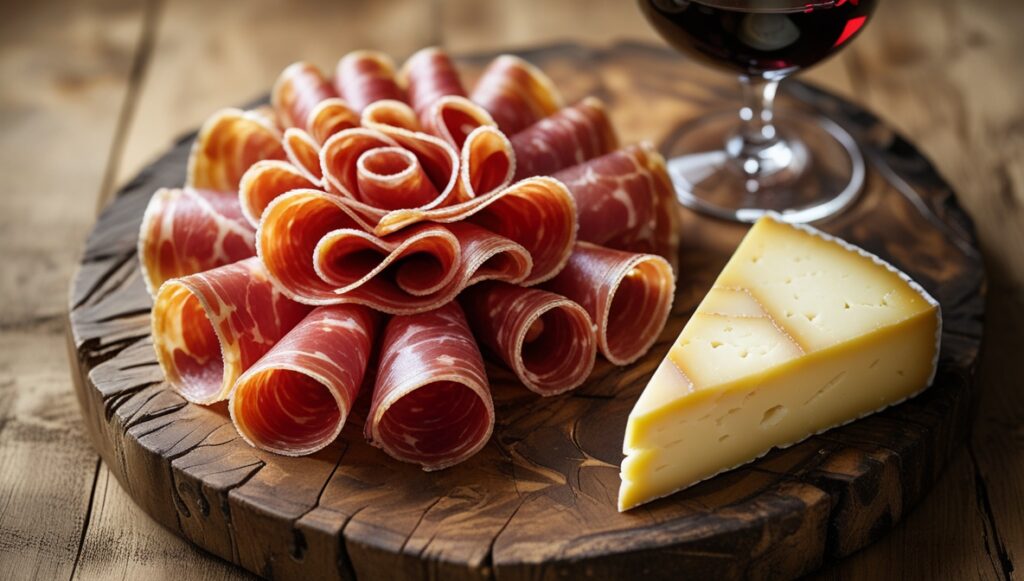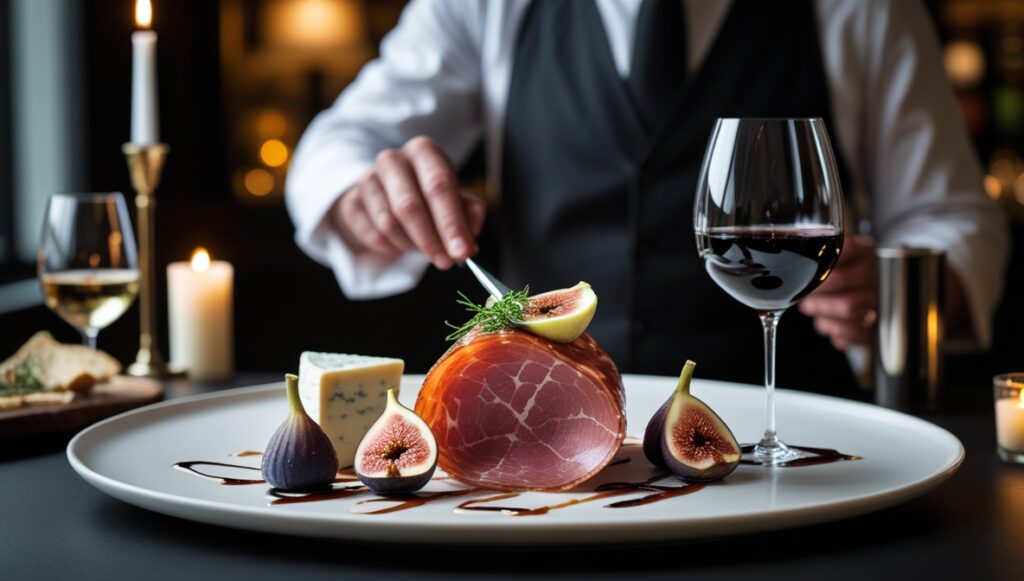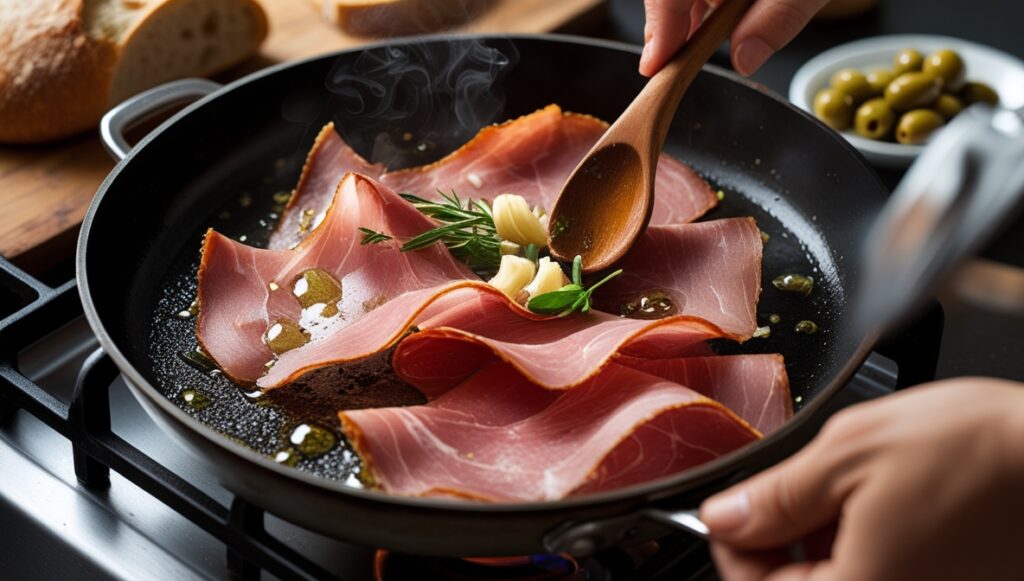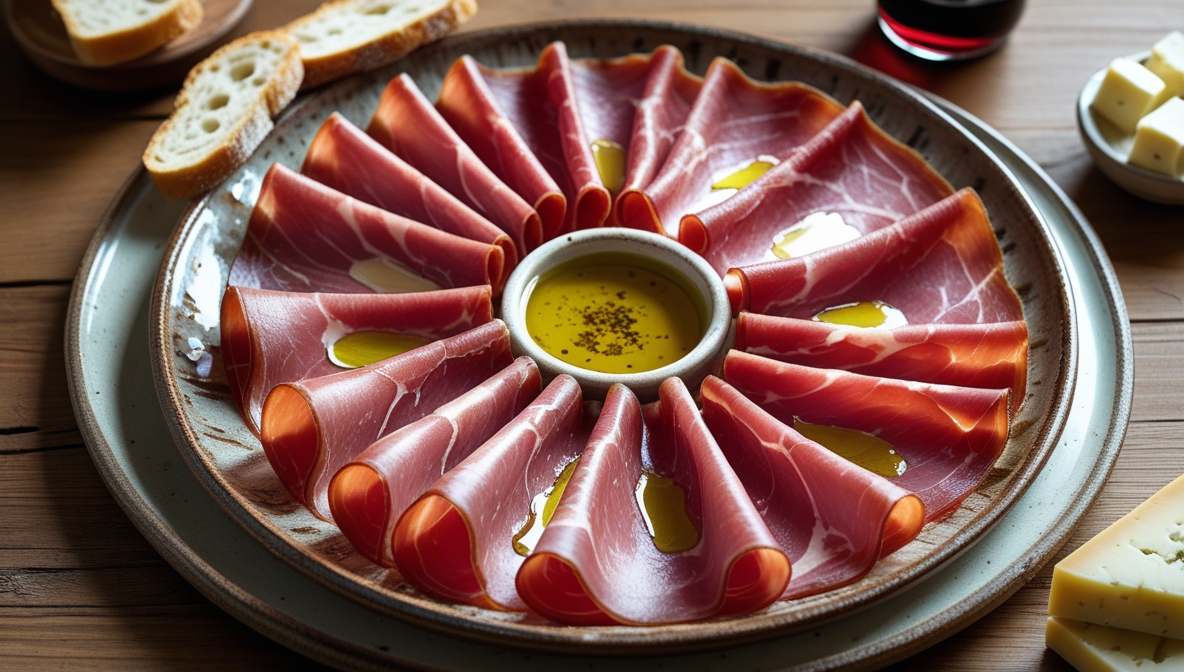Introduction
Few foods symbolize Spanish culture as exquisitely as Jamón Ibérico. This dry-cured ham, known for its intense flavor and melt-in-your-mouth texture, is more than a dish—it’s a gastronomic experience. Revered across Spain and around the world, Jamón Ibérico holds a special place at family tables, in tapas bars, and on gourmet menus.
But what makes this ham so exceptional? From the unique Iberian pigs to centuries-old curing techniques, Jamón Ibérico is a true artisan product that tells a story of tradition, terroir, and taste.


History & Cultural Significance
• Origins
Jamón Ibérico traces its roots back to the time of the Romans, who were among the first to cure and preserve meat. Over centuries, the process was refined, particularly in Extremadura and Andalusia, where the native Iberian pig thrived.
• Royal and Cultural Significance
During the Middle Ages, Jamón was considered a delicacy of the elite. It became a symbol of Spanish identity and Catholic heritage, particularly post-Reconquista, where pork consumption served as a symbol of cultural and religious allegiance.
• Traditions and Celebrations
Jamón Ibérico plays a starring role during Spanish holidays such as Navidad (Christmas), Semana Santa (Holy Week), and local festivals. It’s often served in thin slices on special occasions, shared among family and friends with pride.
Ingredients & Regional Variations
Key Ingredient
-
Iberian pigs (specifically black Iberian pigs)
-
Salt (used during the curing process)
Classification
-
Jamón Ibérico de Bellota – Free-range pigs fed acorns; considered the finest.
-
Jamón Ibérico de Cebo de Campo – Mixed diet, partially free-range.
-
Jamón Ibérico de Cebo – Grain-fed and farm-raised pigs.
Regional Differences
-
Extremadura & Salamanca: Known for Bellota-quality hams.
-
Huelva (Jabugo): Iconic D.O. (Denominación de Origen) for Jamón Ibérico.
-
Los Pedroches (Córdoba): Known for their soft texture and aromatic hams.
Modern Adaptations
While the traditional product remains sacred, creative chefs use Jamón Ibérico in sushi, pasta, croquettes, and fusion tapas globally.
Cooking Process & Difficulty Level

Difficulty Level: Expert-level (if curing from scratch)
Making Jamón Ibérico at home in its authentic form is extremely difficult, as it involves:
Selecting purebred Iberian pigs
Specialized acorn-feeding and free-range care
Long curing (12–36 months in precise humidity conditions)
Home Alternative
If using pre-cured ham, you can:
Store it at room temperature.
Use a jamonero (ham stand) for slicing.
Cut paper-thin slices with a long, sharp knife.
Where to Eat Jamón Ibérico in Spain
Top Recommendations:
Cinco Jotas (Jabugo, Huelva) – Legendary producer of Bellota-grade Jamón.
Museo del Jamón (Madrid) – Popular and affordable.
Mercado de San Miguel (Madrid) – Gourmet food market with tastings.
Casa Lucio (Madrid) – Historic and authentic.
El Pimpi (Málaga) – Classic Andalusian tapas with stunning views.
Michelin Star Spots:
DiverXO (Madrid) – Modern presentation by Chef David Muñoz.
El Celler de Can Roca (Girona) – Haute cuisine that often includes Jamón.
Pairing with Drinks & Side Dishes
Best Drink Pairings:
Fino or Manzanilla Sherry
Cava (Spanish sparkling wine)
Tempranillo red wine
Dry white wines (e.g., Albariño)
Ideal Side Dishes:
Pan con tomate (tomato-rubbed bread)
Manchego cheese
Olives
Almonds or Marcona nuts
Fresh figs or melon for contrast
Fun Facts & Lesser-Known Trivia
Pata Negra: Refers to the black hooves of Iberian pigs.
Celebrity Favorite: Loved by chefs like Ferran Adrià and Anthony Bourdain.
A leg of Jamón Ibérico can cost over €1,000, especially if it’s aged and Bellota-certified.
A properly cured leg can last up to a year if stored correctly.
Health Benefits & Nutrition
Nutritional Highlights:
High in protein
Rich in oleic acid (healthy fat) from acorn-fed pigs
Contains iron, zinc, and B-vitamins
Dietary Adaptations:
Gluten-free
Keto-friendly
Not vegan or vegetarian (but plant-based “jamón” alternatives are emerging)
How to Cook It at Home (Best Jamón Ibérico Recipe)
Ingredients:
100g sliced Jamón Ibérico
Crusty bread or baguette
1 ripe tomato
1 clove garlic
Extra virgin olive oil
Sea salt (optional)
Method:
Toast slices of bread until golden.
Rub with garlic, then a halved tomato.
Drizzle with olive oil.
Top with Jamón Ibérico slices.
Serve immediately.
Tips:
Serve at room temperature for best flavor.
Use thin, hand-cut slices for a melt-in-the-mouth texture.
Global Influence & Fusion Cuisine
Jamón Ibérico has crossed Spanish borders into:
Japanese cuisine (used in sushi rolls)
American fine dining (gourmet charcuterie boards)
Italian fusion dishes (substituted in carbonara)
French restaurants offering tapas menus
Chefs globally now treat it like caviar or truffles—a gourmet ingredient with limited use but immense impact.
Comparison with Similar Dishes
Jamón Ibérico (Spain):
Acorn-fed Iberian ham, aged for up to 36 months; rich, nutty flavor and delicate marbling.Prosciutto di Parma (Italy):
Air-dried ham from Parma; sweeter and more delicate, usually aged 12–24 months.Speck (Italy – South Tyrol):
Lightly smoked, cured ham with juniper and bay leaf seasoning; firmer texture.Bayonne Ham (France):
Mild, subtly sweet ham from the Basque region; less fatty than Jamón Ibérico.Smithfield Ham (USA – Virginia):
Salt-cured, smoked ham; intensely salty and firm, often baked or cooked before serving.

